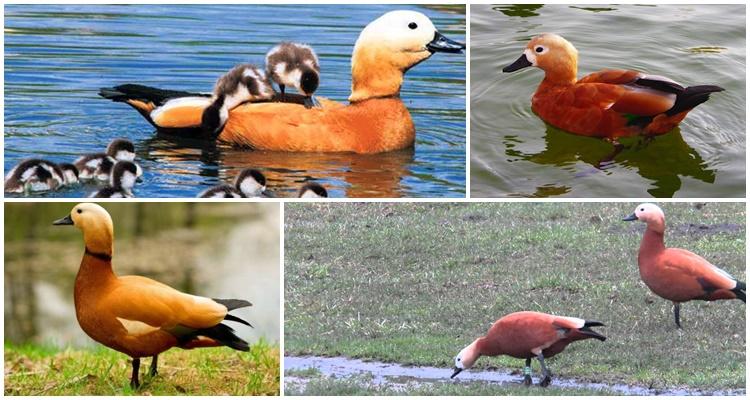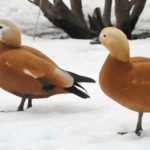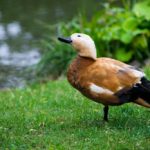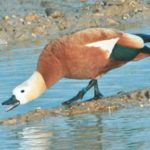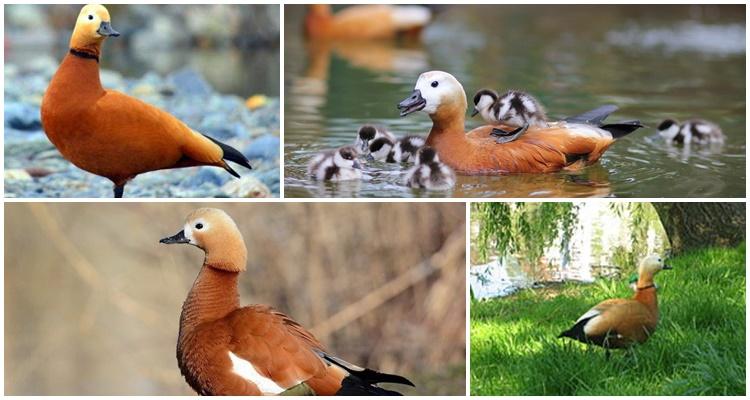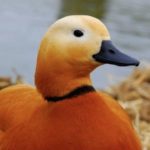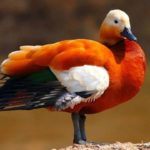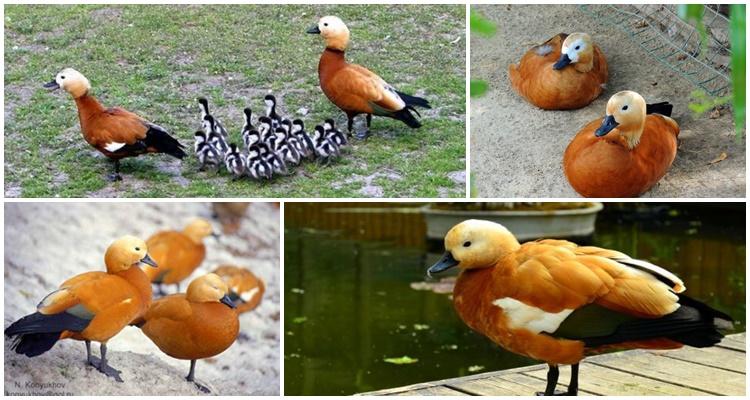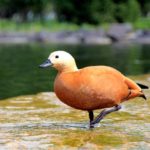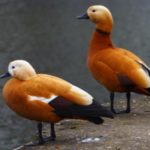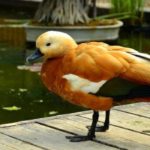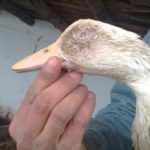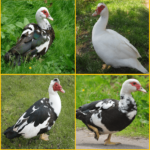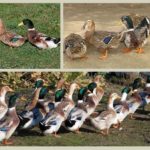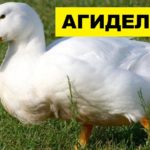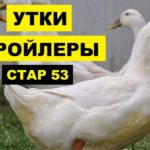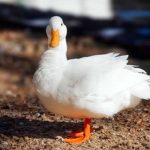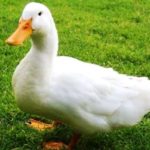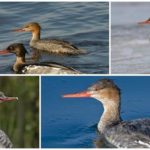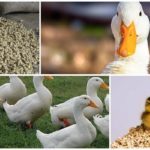You can recognize the scorchfish by its bright, beautiful red plumage and light-colored head. These ducks have long been a favorite of city ponds. Birds do not have a timid character; they know how to fend for themselves. During the period of mating, reproduction and care of offspring, ducks become aggressive and often fight with other waterfowl for territory. They spend the whole summer near bodies of water, and with the onset of cold weather (early November) they fly to warm countries.
Origin and appearance
A bright duck with orange or brown plumage called the Ogar belongs to the duck family, although its lifestyle resembles that of geese (it spends a lot of time on land). These birds with a white (beige) head are easy to distinguish from other waterfowl. Ogar is also called thawed duck, red duck, warnavka, and scoter.
The male and female are very similar to each other. True, in the spring, during the mating season, the drake appears a black “collar” on its long neck, which comes off during molting. The female's plumage is slightly lighter. During the mating season, light spots appear near the eyes of ducks.
The wings of the scorch are white, with dark flight feathers and a greenish speculum. The head and neck of ducks are usually lighter than the body - beige or yellow. The tail is black with a greenish tint. The iris of the eyes, legs and beak are also greenish-black.
Scorches weigh 1.1-1.7 kilograms. Body length - 61-71 centimeters. The wingspan is 1.2-1.4 meters. These ducks have an unpleasant and sharp cry, reminiscent of a goose cackling. Ducks have a louder voice than drakes. Birds make sounds on land, in water and in flight.
Breed Features
Ogars, due to their aggressive nature, are often confused with geese, but these birds are ducks. They have a large body, high legs, a long neck, and a short beak. Unlike their relatives, ducks, burnt ducks move well on land and fly quickly. Birds swim excellently, but dive extremely rarely.
Ogars live in pairs and form relatively small flocks. Females choose their own drakes. Red ducks often behave aggressively towards other waterfowl living in the pond and try to push them out of their territory.
Habitat of the smoldering fire
This species of duck lives throughout Eurasia in steppe and forest-steppe areas near fresh water bodies. Birds prefer open areas. They can settle at a relatively large distance from water. They do not like ponds overgrown with vegetation and salty sea coasts.
These birds can be found on city ponds, lowland rivers, small lakes and artificial reservoirs.
In the summer, fires nest in the temperate zone, and in the winter they move to the subtropical zone. Birds can be found in Bulgaria, Ukraine, Russia, Romania. Ogars winter in India, China, Mongolia, Afghanistan, and Iran. Some flocks prefer to go to Africa (Morocco, Algeria, Ethiopia) and the Canary Islands for the winter. In winter, sturgeons can be found near the Black and Azov Seas, in reservoirs in Turkey and Greece.
In recent decades, a large population of red ducks has been noticed in Moscow. Ogars appeared on the capital's ponds in the middle of the last century, when they were released into the wild from a local zoo. The birds spend the summer on the capital's water bodies. In winter they go to Moscow zoos, where every year they create ideal conditions for wintering.
What does a bird eat?
Ogars are omnivores. Wild birds feed on animal as well as plant foods. Ducks are able to obtain food for themselves both on land and in water. In summer, birds feed by swimming in ponds. They eat various insects, small fish, frogs, various invertebrates, and mollusks.
Burnt fires become active in search of food early in the morning or in the evening. The rest of the day is spent relaxing and swimming in the pond. In winter, the remaining overwintering scorches are allowed to be fed on the pond with special feed for poultry, which can be bought without any problems at any store. It is not recommended to give bread to ducks.
Character and lifestyle
Ogars are migratory birds. They winter in warm countries. They arrive from wintering grounds in March-April. During this period of the year, water bodies in Europe are often covered with ice. At the end of May, females sit on nests. The males are nearby, protecting the clutch. During this period, red ducks, like geese, behave hostilely towards anyone who approaches their nests. The character of fires is restless. Throughout their lives, they fight among themselves for territory, often sorting out relationships with other waterfowl.
In June-July, chicks appear, which adult ducks immediately lead to a nearby pond. The birds swim in the pond all day and come to land at night. For up to eight weeks, drakes and females take care of the offspring, teaching the ducklings to swim, dive, and get food.
After breeding, adult fires begin a period of molting. Ducks lose their feathers and are unable to fly for some time. By the end of summer, the fires acquire new plumage. Late in autumn (in November) they fly to warm countries. Ducks live on average seven years, although they can live longer (10-12 years).
Social structure and reproduction
Ogars are monogamous birds. Pairs of these ducks are formed at the age of two during wintering or during the immediate nesting period, and remain for several years. It is believed that the duck chooses its own male.It’s just that the drake behaves more restrained during mating games - he stands with his neck outstretched or, conversely, with his head down, he walks around the duck. The female, opening her beak, screams loudly, attracting the attention of the male, circling around him, spreading her wings.
During this period, paired flights of birds can be observed. After mating rituals, as a rule, mating of ducks occurs.
Scorch nests are usually made on land, lined with down, thin branches and dry grass. For nesting they can use empty fox and badger holes, crevices in rocks near water bodies, depressions in coastal cliffs and even abandoned construction sites and attics of residential buildings.
Smoldering eggs are laid at the end of May. The clutch contains no more than 6-11 cream or greenish eggs. The female sits in the nest for about 27-30 days. The drake is nearby, protecting the offspring. When dangerous birds or animals approach the nest, females emit a sound somewhat similar to the hissing of snakes. The males begin to attack the enemy.
When the chicks appear, ducks and ducklings leave the nest. Adult birds that had nests on top of residential buildings fly off the roofs. Behind them, ducklings fall down without harm to their health. Ogars lead their offspring to the nearest body of water. Small birds, instead of feathers, have fluff with brown and light spots. If there are several broods of scorches on a pond, the defeated parents may abandon their chicks. Then the ducklings join someone else's family. For several weeks, the chicks live with adult ducks, feeding on insects and duckweed. At eight weeks, the ducklings fly and become independent.
Natural enemies
In the wild, red ducks are hunted by various predators (foxes, wolves, raccoons, martens) and birds of prey (kites, hawks).Small ducklings living with their parents on city ponds can become prey to dogs, cats, seagulls, and crows. When ducks are in danger, they scream loudly, flap their wings, protecting the chicks, and often enter into battle with a stronger enemy.
Population and species status
Ogars are listed in the Red Book of Russia and Ukraine and have the status of rare birds. True, the likelihood of these ducks disappearing is low. However, sardines are classified as birds whose numbers are critically small (about 220 thousand individuals). In the European part of Russia there are almost 16 thousand pairs of these ducks, and in the southern Asian regions there are 5-7 thousand pairs. There are approximately 2,500 birds living in Africa. There are about 360 pairs of red ducks in Ukraine, and on the territory of the Askania Nova Nature Reserve there are another 200 pairs of ruddy ducks.
Smoldering Hunting
Hunting red ducks is prohibited. Ogars are an endangered species of waterfowl. The number of these birds is low. In many reserves, wild ducks are provided with favorable conditions for nesting and breeding. Schar populations are protected by law. Administrative liability has been introduced for the destruction of wild ducks. If desired, cinders can be grown at home. One individual costs about $100.
Maintenance and care in captivity
Ducks were domesticated several thousand years ago. Birds are bred for dietary meat, tasty eggs, and duck down. As for the scorched ducks, these ducks are kept in captivity, as a rule, for decorative purposes, that is, to decorate reservoirs. The birds attract breeders with their original red brick plumage.
True, raising cinders at home has other benefits. When fed with balanced feed, these birds quickly gain weight.Unlike their wild relatives, fires recover well and can weigh 4-6 kilograms. Their meat is juicy, tender, tasty and very nutritious. At six months of age, females begin to lay eggs. They produce up to 120 eggs per year. Ogars are also bred for their soft down, which is used to make duvets and clothing.
Ducks are fed crushed grain mixtures, mixed feed, sprouted grains, cereals, finely chopped grass, and vegetables. A poultry house is set up to keep birds. Ogars sleep on the floor covered with straw. In winter, the temperature in the poultry house should not fall below +7...+10 degrees Celsius. In summer, birds can stay outdoors all day.
Near the poultry house they are equipped with a walking area with a feeding trough and a drinking bowl. It is advisable that the fires have access to an open body of water. During the mating and breeding season, it is recommended to keep ducks separately from other poultry. During this period of time, the fires become aggressive and often attack the inhabitants of the poultry yard.




